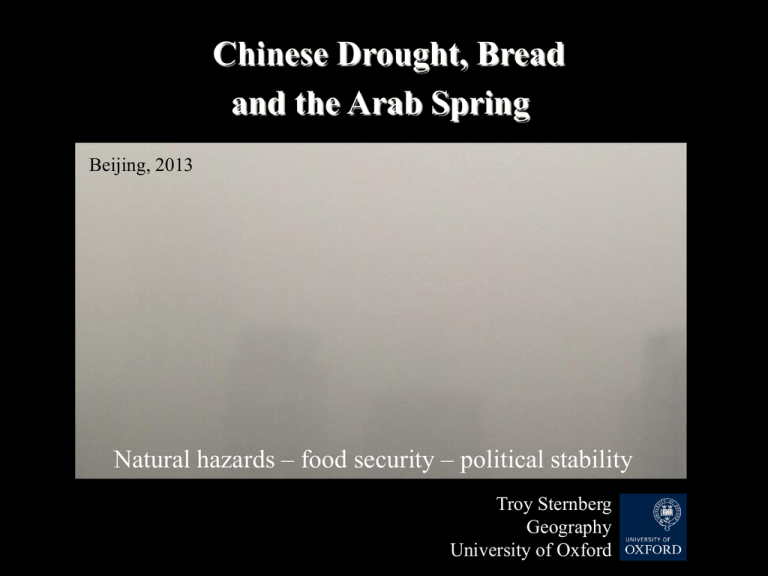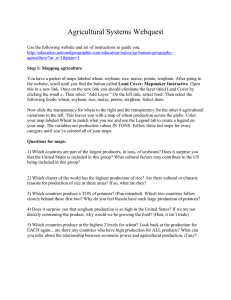Chinese Drought, Bread and the Arab Spring
advertisement

Chinese Drought, Bread and the Arab Spring Beijing, 2013 Natural hazards – food security – political stability Troy Sternberg Geography University of Oxford Great Wall Selden Map, ca 1620 ‘Barbarians to the north’ China . . . • 22% of world’s people, 7% of water • 4 million km2 – largest dryland country in Asia • 60% agricultural production in northern China, 12% of the water • Farmland – decreased >6% 1997-2006 • > 50% urban Climate change – 1.50C temperature increase Climate hazards: 2008 – ice storms, 77 million people 2009-10 – drought in south, 60 million people 2010 – floods, 134 million people Drought problem solution Grandpa Wen’s Forest before after Globalization of hazards: Chinese drought, Bread and the Arab Spring Egyptian change – political and economic causes High cost of living 40% poverty rate Bread as a symbol of protest WHEAT ‘Non-political Bread Riots are Breaking Out in Egypt, Killing Three’ Wall Street Journal, Feb 01, 2011 WHEAT Role of the global market 2010 – decrease in world wheat production by major exporters Russia, Ukraine – drought, extreme heat Canada – cold, excessive rain Australia – excessive rain Changing climate patterns – El Nino, Pacific Oscillation Only 6-18% of wheat harvest exported 2010 Wheat Production Country Metric tons Increase/ (in '000s) decrease China 114,500 -0.54% US 60,103 -0.44% Russia 41,500 -32.74% Canada 23,167 -13.71% Ukraine 16,850 -19.38% Australia 13,500 -8.72% 2010 Wheat Imports Rank Country Metric tons (in '000s) 1 Egypt 9,800 2 Brazil 6,000 3 Algeria 5,300 4 Indonesia 5,300 5 Japan 5,200 Egypt – wheat low-value crop Grew higher value flowers and mangoes for export Egypt 3% of GDP spent on wheat subsidies 1/3 of calories from bread ‘Bread Intifada’ 1977 Bread riots – 2008 August 2010 –Russia stops wheat export to Egypt Army runs wheat distribution system •Egypt imports from majors, Argentina, Romania, Kazakhstan… China largest wheat producer/consumer usually self-sufficient largest foreign reserves Nov. 2010 – lack of rain concern about winter wheat (22 - 90% of total) crop failure China buys wheat on international market Government maintaining ‘social stability’ Wheat region Shangdong, Henan, Anhui – 250+ million people Drought Standard Precipitation Index through Feb. 28, 2011 Months Anqing Anyang Bengbu Bozhou Dongtai Huoshan Jinan Laohekou Nanjing Wuhan Xinyang Zhenzhou 1 -0.85 -0.48 -1.63 -1.37 -1.94 -0.72 -0.75 -1.26 -1.33 -1.21 -1.71 -0.85 2 -0.56 -1.19 0.01 -2 -0.67 -0.96 -1.26 -1.5 -0.9 -1.32 -2.6 -1.65 3 -1.41 -2.1 -1.05 -3 -1.77 -2 -2.1 -2.1 -1.86 -1.93 -2.7 -2.7 SPI drought values:<-1 moderate, <-1.5 severe, <-2 extreme drought Mckee et al. 1993, Wu et al. 2005, Sternberg et al. 2010 Central Agricultural region – 525 million people Drought timescale ‘worst in communist party history’ 3 month 6 month Government - $1.9 billion aid, irrigation, wells, water delivery Effect of drought on global wheat prices Wheat imports per capita 2010 - Wheat Imports per Capita Per Capita Rank Country Metric tons Income Food - % per million 1 2 3 4 5 6 7 8 9 10 220% increase UAE Libya Israel Jordan Algeria Tunisia Yemen Egypt Iraq Cuba 370.659 242.803 238.968 173.611 101.439 89.330 86.843 81.284 76.701 70.503 US$ of income 47,400 9 12,062 37 27,085 18 4,435 41 4,477 44 4,160 36 1,230 45 2,771 39 2,625 35 5,000 n/a Countries impacted Future? _______________________ Sternberg, T. 2011. Regional Drought has a global impact. Nature. 472:169 Sternberg, T. 2012. Chinese Drought, Bread and the Arab Spring. Applied Geography, 34: 519-524. New York Times, March 3, 2013 – Opinion-Editorial Soybeans • 60% of world’s soybeans exported to China • 83% of soybeans imported from US, Brazil, Argentina • 16% demand increase - record 69 million metric tons pigs cows chickens Meat consumption quadrupled in 30 years, 75% protein from pork Litres of water needed per kg: vegetables - 322, pork - 6,000, beef 15,400 Environmental Challenges • • • • • • • • 300 million people live on <$2 / day 70% water unfit for human touch North China – half groundwater unfit for industry Coal processing consumes 1/6th of China’s water Pollution – northerners die 5.5 years earlier (coal heating) Air – Beijing ‘worst in world’? Particulate reaches US 20-30% cropland contaminated (arsenic, lead, mercury etc) Food safety/security China - 34% income on food. UK – 9% • 64% $ millionaires seeking 2nd residency Arsenic in Yunnan Environmental rehabilitation • • • • $635 billion on water projects, e.g. South-to-North canal $76 billion on air $5 billion on soil $35 billion desertification Drinking water for Beijing ‘pipeline from Lake Baikal’ Chinese Academy of Sciences, May 2014 Agricultural land Model anti-desertification Role for the UK ? Britain used as model for China ‘London's air pollution policies may help Beijing’ China Daily, 2013 Expertise, technology Environment, Water, Food Thank you




